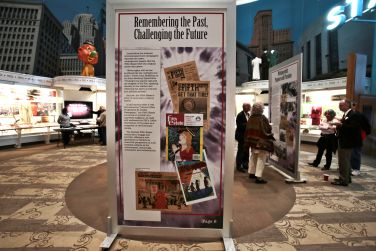Fifth Estate Collective
The FE at 50
Fifth Estate celebrates a half century of radical publishing

This edition of the Fifth Estate marks the 50th anniversary of its publishing, with much of the celebrations occurring in a manner we never anticipated. There are exhibitions at two prestigious Detroit museums, a jammed packed dance/ concert with hundreds in attendance featuring The Layabouts, an anarchist rock/ska band, talks to the Detroit Press Club, radio and TV coverage, art and political workshops and panels at the museums, and tours with university classes and other groups at the museums which are selling Fifth Estate t-shirts. Whew!
Little is lost of this publication’s radicality in the exhibits, but what does it mean when mainstream institutions give such recognition to a magazine which fashions itself as an enemy of the state? Yippie founder Abbie Hoffman once said, if they don’t jail you, and they don’t kill you, they’ll eventually honor you. More on this below.
As it is, it is very unusual for a radical oppositional paper to outlive the period of contestation in which it was conceived.
The Fifth Estate and a handful of other tabloid newspapers began publishing in 1965, a tumultuous period already set in motion by the valiant struggle of the civil rights and black power movements.

The Fifth Estate was quickly joined by hundreds of other regularly appearing papers to the extent that by 1970, the Underground Press Syndicate could claim 500 publications with a total weekly circulation of four million readers. It’s impossible to count the irregularly appearing ones including at least 100 published inside the U.S. military by anti-Vietnam war GIs, plus ones printed by rebellious high schoolers, labor caucuses, and community groups.
Although these papers, like the movements they reported on, brought forth individual instances of insightful and talented writers and artists, they virtually created and wrote themselves. So intense was the resistance to a stultified society and culture defined by white privilege and empire, so self-satisfied were the defenders of the post-World War II triumphalism of an American Century, that voices of reform and revolution arose in protest.
In similar periods of revolt, particularly one lasting another half-century from 1890 to 1940, hundreds of publications, perhaps thousands came into being advocating labor rights, reform, anarchism, socialism, and communism. It’s difficult to imagine now that the anarcho-syndicalist Industrial Workers of the World (IWW) among its many papers, printed a Finnish language weekly edition a hundred years ago with a circulation of 30,000 in the north country of Michigan, Wisconsin, and Minnesota.
Many papers that began in the 1960s, such as this publication, carried the vision of simultaneous World Revolution and Age of Aquarius in their pages. They exuded rage against a murderous and unjust system, and a joy at a new found culture based on love, experimentation, and joy.
However, most of this crashed as rapidly and completely as the demise of the Passenger Pigeon beginning with the inexplicable 1972 presidential reelection of the war criminal, Richard Nixon, the end of the military draft and combat in Vietnam by U.S. forces, and sheer exhaustion on the part of a movement of resistance mostly propelled by young people in their teens and twenties.
By 1974, most of the papers had ceased to exist, but the Fifth Estate valiantly continued on, attempting to reinvent itself as a precursor of the now ubiquitous hip weeklies while still maintaining its radical edge.
At a point of near financial collapse of the FE in 1975, several people formerly associated with the paper constituting themselves as the Eat The Rich Gang, stepped into the breach left by the almost complete disappearance of the former staff. They immediately published what the front page headline announced as the “Last Issue.”
The supporting article explained that the paper would no longer accept commercial advertisements or pay salaries, and that the editorial commitment was shifting back to its original ideas. Or, in the words of a 1971 FBI report: “The Fifth Estate supports the cause of revolution everywhere.” Nicely put, guys. So nice that it often appears on our cover.
The reason that 499 other papers ceased publishing was because they had essentially run their course. The Fifth Estate continued to print because the Eat the Rich Gang and, hence, the publication, became infused with radical ideas discovered by them of ultra-leftism, council communism, and anarchism.
The influence of Fredy Perlman, Jacque Camatte, Jean Beaudrillard, and others continue to define Fifth Estate perspectives today although usually not directly espoused as they were in these pages in the mid- to late-1970s.
Contrary to the previous period when content was driven by action and a revolutionary optimism, the new theories read by the publishing collective in the 1970s, existed mostly on an intellectual level with sectarian debate and denunciations of authoritarian leftists appearing frequently.
It seemed as though the total domination of capital had been achieved with the defeat of its ostensible main rivals of socialism and communism. The understanding was cold comfort to the staff as it left the Fifth Estate’s new ideas and the articles it generated extremely marginalized.
However, as critiques of civilization and industrialism began to take shape in these pages, and an opposition of radical ecology arose in the 1980s, the paper and its staff began active participation in campaigns against nuclear power, war, and assaults on the environment.
With the re-emergence of a vibrant anarchist movement in the 1990s, the Fifth Estate found a milieu in which there was a general feeling of solidarity, although not without periodic disagreements with some individuals and tendencies. The FE continues its tradition of reporting on the disruptions and challenges to the toxic routines of industrial civilization, the economy of capitalism, and its administrative apparatus, the political state.
With the anarchists of generations before, we maintain their vision of The Ideal, the new society they carried in their hearts. But, we also explore new liberatory ideas knowing that the future can write itself in struggle.
But, back to the question of being not only recognized, but honored by mainstream institutions. Frankly, it was a bit surprising, particularly having a radical paper displayed at the Detroit Historical Museum, a centerpiece in the city’s cultural center since 1928. It’s a wonderful facility which chronicles the rich history of the urban area, so presenting our story wasn’t as far a reach as it initially seemed.
The Fifth Estate exhibit stands in the center of the main gallery, and features seven vertical panels tracing the paper’s origins, mostly remaining in the time frame of 1960 and ‘70s radical nostalgia. However, it also announces very clearly the magazine’s current existence as an anarchist publication. There are photographs of marches with demonstrators carrying Viet Cong flags, an array of front covers including ones of kids throwing bottles at cops, and calls for revolution, plus a large reproduction of a current edition.
We wondered whether there would be a right-wing backlash against the exhibit much in the same manner that followed the installation of the Diego Rivera “Detroit Industry” murals in the early 1930s at the near-by Detroit Institute of Arts. But so far the FE exhibit has been featured on radio and TV programs without any protest.
Overall, the presentation is gorgeous, thanks to the in credible commitment and skill of the museum staff, and will remain in place until August 2016. The museum printed 10,000 8 1h X 5 1h postcards to promote the exhibit!
A half mile away from this exhibit is another devoted to the Fifth Estate at the Museum of Contemporary Art Detroit (MOCAD). This 4-room exhibition mostly features the paper’s graphic content, which is what has always made its articles come alive. Its presentation has a more radical cast to it and although there are many artifacts from the earlier period, a visitor is met immediately by a poster announcing, “Love & Anarchy: The Only Way.”
There is the FE’s infamous forgery of a Detroit daily newspaper displayed with the headline, “Christ’s Body Found: Easter Canceled,” our famous “Fuck Authority” poster, one stating, “Fuck the Draft,” as well as other items exemplifying the paper’s radical past and present. None of the “F” bomb posters made it into the more staid Detroit Historical Museum, we were told, since public school classes often visit there.
The museum hosted well-attended panels on “Art as Political Force,” and another on the politics of the FE.
The MOCAD exhibition is in a museum facility behind the main building named the Mike Kelly Mobile Homestead, considered an art piece in itself, and described as a place to “establish participatory and socially transformative art.” The FE installation is more DIY than the very professional one installed at the Detroit Historical Museum, but its overall presentation seems very striking to most visitors. A half-hour documentary featuring interviews with past and present magazine staff is part of the display which is also on our web site.
Museum staff report that this exhibition has had higher attendance than any previous ones in that facility.
The MOCAD staff have been generous with their skills and time in assisting the Fifth Estate curators who had little previous experience with such an undertaking. The exhibition runs until January 3, 2016.
None of the foregoing addresses the question of what does it mean that a radical publication is no longer ushered out the door but rather is invited in. We’ll leave that answer to our readers and museum visitors. Your reactions are welcome in our Letters section.
In the meantime, we’re looking for some 25-year-olds, who want to sign up to carry out the Fifth Estate’s 100th anniversary celebration.
For information on the exhibits, including hours and directions, visit our web site at FifthEstate.org.
Longer histories of the Fifth Estate, plus posters, and excerpts from the publication’s first four decades are available online in our 40th anniversary edition at FifthEstate.org. Visit the Archive section and go to #368–69, Spring-Summer 2005.
You can also find hundreds of other articles from past issues in the archive, which is constantly growing.
